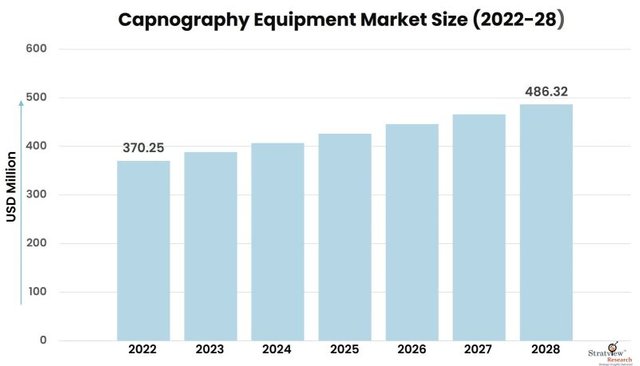Capnography Equipment Market Overview: Key Trends and Growth Forecasts
The capnography equipment market is witnessing robust growth, driven by an increasing focus on patient safety, the rising prevalence of respiratory diseases, and the expanding use of capnography in various healthcare settings. Capnography, a non-invasive monitoring tool that measures the concentration of carbon dioxide (CO2) in exhaled breath, has become essential in modern medicine, particularly in anesthesia, intensive care, and emergency departments. This article provides an overview of the key trends and growth forecasts for the capnography equipment market.
Growth Forecasts
According to Stratview Research, the capnography equipment market was estimated at USD 370.25 million in 2022 and is likely to grow at a CAGR of 4.6% during 2023-2028 to reach USD 486.32 million in 2028.

Market Growth Drivers
1. Rising Prevalence of Respiratory Disorders: The growing incidence of respiratory disorders such as chronic obstructive pulmonary disease (COPD), asthma, and sleep apnea is a major factor driving the demand for capnography equipment. As these conditions require continuous monitoring of respiratory status, capnography offers a reliable method to assess ventilation and metabolic function, ensuring timely intervention and improved patient outcomes.
2. Increased Focus on Patient Safety: There is an increasing emphasis on patient safety across healthcare settings, especially during surgical procedures and sedation. Capnography provides real-time monitoring of a patient’s respiratory status, helping to detect hypoventilation, airway obstructions, or ventilator malfunctions early. This proactive approach to patient monitoring is fueling the adoption of capnography equipment in hospitals and clinics worldwide.
3. Technological Advancements: Continuous advancements in capnography technology, including the development of portable, compact, and wireless capnography devices, have expanded the market. These innovations provide greater flexibility and ease of use, making capnography accessible for use in ambulances, home care settings, and during patient transport. Furthermore, the integration of artificial intelligence (AI) and machine learning (ML) algorithms is enhancing the accuracy of capnography readings and enabling predictive diagnostics.
Key Market Trends
1. Growing Adoption in Non-Hospital Settings: The use of capnography equipment is no longer limited to operating rooms and intensive care units. Its application has expanded to pre-hospital care, procedural sedation, pain management, and even home care settings. The trend towards ambulatory care and the growing need for portable monitoring solutions are contributing to this shift.
2. Shift Towards Mainstream Monitoring Practices: Capnography is becoming a standard monitoring practice, particularly in critical and emergency care settings. Its ability to provide continuous and comprehensive respiratory monitoring makes it invaluable for early diagnosis and intervention, improving overall patient safety and outcomes.
3. Emerging Markets Present Significant Opportunities: Emerging markets, particularly in Asia-Pacific, Latin America, and the Middle East, present significant growth opportunities due to the rising healthcare expenditure, increasing awareness about patient monitoring, and the growing burden of chronic diseases. These regions are expected to witness rapid adoption of capnography equipment as healthcare infrastructures continue to develop.
Conclusion
The capnography equipment market is poised for significant expansion, driven by technological advancements, a focus on patient safety, and the rising burden of respiratory diseases. As healthcare providers continue to recognize the value of real-time respiratory monitoring, the demand for capnography equipment is expected to grow, paving the way for innovations and new market opportunities in the years ahead.